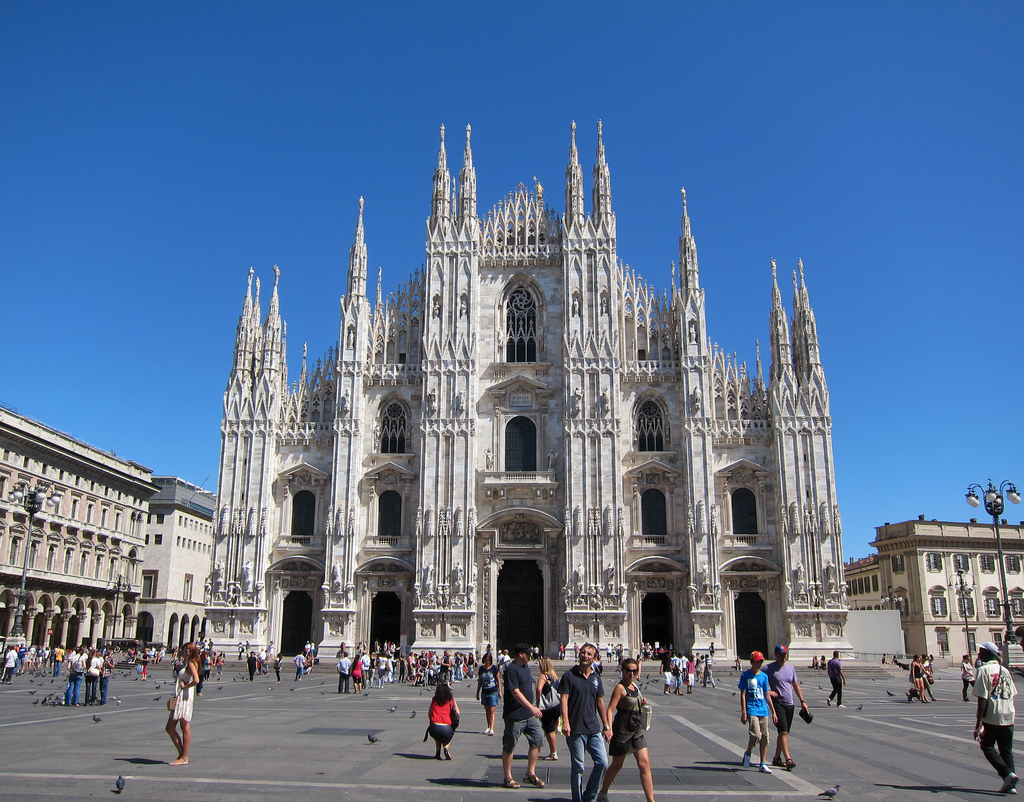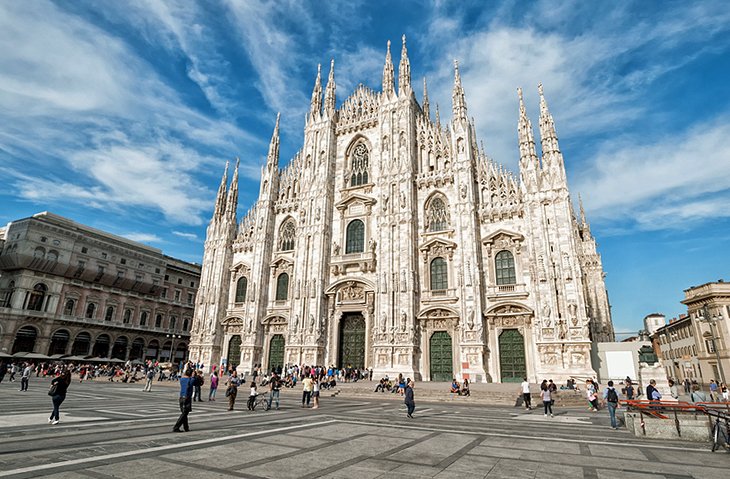
Milan, the fashion capital of the world, is a city that pulsates with a unique blend of historical grandeur and cutting-edge contemporary flair. Beyond the runways and designer boutiques, Milan offers a rich tapestry of art, architecture, culinary delights, and a vibrant urban energy that captivates every visitor. From its iconic Duomo to its hidden courtyards and innovative design districts, Milan is a city that rewards exploration, promising an unforgettable experience for all who wander its streets.
A Storied Past: From Roman Origins to Renaissance Powerhouse
Milan’s history is as layered and complex as its iconic fashion houses. Founded by Celtic tribes, it was conquered by the Romans in the 3rd century BC and became Mediolanum, a significant administrative and military center. During the Late Roman Empire, it even served as the imperial capital for a period.

Related Articles about Milan: A Symphony of Style, History, and Innovation:
- Beyond the Fairytale: Unveiling the Treasures of the Czech Republic
- Phuket: A Jewel of the Andaman Sea – Exploring Paradise Found
- Hong Kong: A Symphony of Sights, Smells, and Stories
- Unveiling the Vibrant Soul: A Comprehensive Guide to Ho Chi Minh City
- Paris: A Timeless Guide to the City of Lights
The city’s fortunes fluctuated through the medieval era, experiencing periods of prosperity and conflict. However, it was during the Renaissance that Milan truly blossomed. Under the rule of the Visconti and later the Sforza families, it became a formidable political and cultural power. This era saw the commissioning of masterpieces like Leonardo da Vinci’s "The Last Supper" and the initial construction of the magnificent Duomo.
The following centuries brought foreign domination, including Spanish, Austrian, and French rule, each leaving their architectural and cultural imprint. The 19th century saw Milan become a focal point of the Italian Risorgimento, the movement for Italian unification, solidifying its importance within the newly formed Kingdom of Italy. In the 20th century, Milan emerged as a powerhouse of industry, finance, and, of course, fashion, a legacy that continues to define its modern identity.
Unveiling Milan’s Crown Jewels: Top Attractions
Milan’s allure lies in its diverse array of attractions, catering to a multitude of interests:
-
The Duomo di Milano (Milan Cathedral): No visit to Milan is complete without marveling at its breathtaking Gothic cathedral. This colossal masterpiece, the third-largest church in the world, took nearly six centuries to complete. Its intricate facade, adorned with thousands of statues and spires, is a testament to human dedication and artistic brilliance. Ascend to the rooftop for panoramic views of the city and a closer look at the delicate stonework and the Madonnina, the golden statue of the Virgin Mary that watches over Milan.
-

Galleria Vittorio Emanuele II: Directly adjacent to the Duomo, this opulent 19th-century shopping arcade is a dazzling spectacle of glass and iron architecture. Named after the first king of unified Italy, it’s often referred to as "Milan’s Drawing Room." Browse high-end boutiques, enjoy a coffee at a historic cafe, or simply soak in the elegant atmosphere. Don’t forget to spin on the mosaic bull in the center of the dome, a local tradition said to bring good luck.
-
La Scala Opera House: A pilgrimage for opera and ballet aficionados, Teatro alla Scala is one of the world’s most prestigious performing arts venues. Even if you don’t attend a performance, a guided tour of its opulent interiors, including the auditorium and museum, offers a glimpse into its illustrious history and the legendary artists who have graced its stage.
-
Leonardo da Vinci’s "The Last Supper": Housed in the refectory of the Convent of Santa Maria delle Grazie, this iconic fresco is a profound masterpiece of Renaissance art. Due to its fragility, access is strictly limited, and tickets must be booked months in advance. The experience of standing before this profound depiction of Christ and his disciples is deeply moving and utterly unforgettable.
-
Sforza Castle (Castello Sforzesco): This imposing fortress, once the seat of the Sforza dukes, is a significant historical landmark. Today, it houses several of Milan’s civic museums, including the Museum of Ancient Art, the Pinacoteca, and the Museum of Musical Instruments. Explore its courtyards, ramparts, and diverse collections, offering a comprehensive overview of Milan’s artistic and historical heritage.
-
Pinacoteca di Brera: For art lovers, the Brera Art Gallery is a treasure trove of Italian Renaissance masterpieces. It boasts an impressive collection featuring works by Raphael, Caravaggio, Bellini, and many others, offering a deep dive into the evolution of Italian painting. The charming Brera district surrounding the gallery is also worth exploring, with its bohemian atmosphere and artisan shops.
-
Navigli District: This charming canal district, once the city’s lifeline for trade and transport, has been revitalized into a trendy hub of bars, restaurants, and boutiques. Particularly lively in the evenings, the Navigli canals offer a picturesque setting for an aperitivo or a leisurely stroll, especially during the famous "aperitivo" hour when many establishments offer complimentary snacks with drinks.
-
Quadrilatero della Moda (Fashion Quadrangle): For those with a passion for fashion, this exclusive district is a must-visit. Home to flagship stores of iconic Italian and international designers like Gucci, Prada, Versace, and Armani, it’s a dazzling display of luxury and sartorial excellence. Even if your budget doesn’t stretch to a purchase, window shopping here is an experience in itself.
-
Modern and Contemporary Art: Milan is a vibrant center for modern and contemporary art. The Fondazione Prada offers striking architectural spaces and thought-provoking exhibitions. The Triennale di Milano showcases design, architecture, and contemporary art, often with innovative and engaging displays.
-
Parco Sempione: Located behind Sforza Castle, this vast public park is a green oasis in the heart of the city. It’s a perfect spot for a leisurely walk, a picnic, or to admire the Arco della Pace (Arch of Peace), a monumental neoclassical arch at its western end.
Navigating Milan: Travel Tips for a Smooth Journey
To make the most of your Milanese adventure, consider these practical tips:
- Book in Advance: For popular attractions like "The Last Supper" and rooftop access to the Duomo, booking tickets online well in advance is crucial to avoid disappointment.
- Embrace the Aperitivo Culture: Experience the quintessential Milanese tradition of aperitivo. From late afternoon to early evening, bars offer drinks accompanied by a generous spread of snacks, making it a delightful and affordable pre-dinner experience.
- Learn Basic Italian Phrases: While English is spoken in tourist areas, knowing a few basic Italian phrases like "Buongiorno" (Good morning), "Grazie" (Thank you), and "Scusi" (Excuse me) will be greatly appreciated.
- Comfortable Shoes are Essential: Milan is best explored on foot. You’ll be doing a lot of walking, so comfortable footwear is non-negotiable.
- Be Mindful of Pickpockets: Like any major city, be aware of your surroundings and keep your valuables secure, especially in crowded tourist areas and on public transport.
- Dress Appropriately for Churches: When visiting churches, including the Duomo, ensure your shoulders and knees are covered as a sign of respect.
Resting Your Head: Accommodation Options in Milan
Milan offers a wide spectrum of accommodation to suit every budget and preference:
- Luxury Hotels: For an opulent experience, the city boasts world-class luxury hotels in prime locations, often within the Fashion Quadrangle or near major attractions. Expect impeccable service, elegant decor, and top-tier amenities.
- Boutique Hotels: Milan has a growing number of stylish boutique hotels offering unique character, personalized service, and a more intimate atmosphere. These are often found in charming neighborhoods like Brera or the Navigli district.
- Mid-Range Hotels: Numerous well-appointed mid-range hotels offer comfortable stays with good facilities, often located slightly outside the most central areas but still with convenient access to public transport.
- Budget-Friendly Options: Hostels and budget hotels are available, particularly for solo travelers or those on a tighter budget. Look for options near train stations or in up-and-coming neighborhoods.
- Apartment Rentals: For longer stays or families, renting an apartment can be a cost-effective and convenient option, offering more space and the ability to self-cater.
Getting Around Milan: A Seamless Transportation Network
Milan boasts an efficient and integrated public transportation system:
- Metro (Metropolitana): The Milan Metro is the most efficient way to navigate the city. It has several lines that connect major attractions, train stations, and key areas.
- Trams and Buses: A comprehensive network of trams and buses complements the metro, providing access to areas not covered by the subway. Trams, in particular, offer a charming way to see the city.
- Taxis: Taxis are readily available, but can be more expensive. Ensure the meter is used.
- Ride-Sharing Services: Popular ride-sharing apps are also available for convenient point-to-point transportation.
- Walking: As mentioned, Milan is a wonderfully walkable city, and many attractions are clustered together, making it a pleasant way to discover its hidden gems.
- Biking: Bike-sharing services are increasingly popular, offering a sustainable and enjoyable way to explore the city, especially along the canals and through parks.
The Perfect Time to Visit Milan: Embracing the Seasons
Milan’s climate offers distinct experiences throughout the year:
- Spring (April-May): This is arguably the best time to visit. The weather is mild and pleasant, ideal for exploring the city on foot. Gardens are in bloom, and outdoor cafes come alive. Expect moderate crowds.
- Summer (June-August): Summers in Milan can be hot and humid, with temperatures often exceeding 30°C (86°F). While there are fewer crowds due to holidays, outdoor activities can be less comfortable. Many Milanese also leave the city for vacation during August.
- Autumn (September-October): Another excellent time to visit. The weather is generally pleasant, with crisp air and beautiful autumn foliage. Fashion Week in September and October draws a stylish crowd, and the city buzzes with energy.
- Winter (November-March): Winters are cold but generally not extreme, with occasional rain and a chance of snow. This is the low season, meaning fewer crowds and potentially lower prices. The festive atmosphere leading up to Christmas is a highlight, with markets and festive decorations.
Beyond the Icons: Milan’s Enduring Appeal
Milan is more than just its famous landmarks. It’s a city that thrives on innovation, design, and a sophisticated lifestyle. Explore its design districts like Tortona and Isola, where avant-garde galleries and showrooms showcase the latest in Italian creativity. Indulge in its world-renowned culinary scene, from traditional trattorias serving hearty Lombard cuisine to Michelin-starred restaurants pushing the boundaries of gastronomy.
Whether you’re drawn by its artistic heritage, its fashion-forward spirit, or its vibrant urban pulse, Milan promises an enriching and inspiring journey. It’s a city that effortlessly blends the old with the new, a place where every corner holds a new discovery, and where the echoes of history resonate beautifully with the rhythm of modern life. Come to Milan, and let its captivating charm unfold before you.





